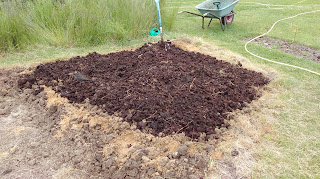Creating the best vegetable bed
Each time I create a new veg bed I have tried to do it differently to find the quickest and best ways of creating a bed.
- No dig bed made on top of grass - OK but when the soil is mainly clay there is a plough pan and water will puddle on top of this and plant roots don't penetrate very well. Weeds grow through. Have given up with this style of bed, wasn't impressed. Didn't address flooding issue. Plant roots only have depth of added material to grow in.
- Up turning the turf, breaking it up a bit and piling manure and compost on top - similar to a no dig bed but still leaves a plough pan and weeds come through easily. Helps drainage a bit but it seems a waste to not use the soil below ground and in essence this is a raised bed without built up edges. Takes a lot compost or manure to make the bed and doesn't use much of the nutrients already present if the plant roots don't go down into the up turned turf.
- Removing turf, digging the soil to a fork depth - works fine, drains OK but over time the dug soil just clumps back up to normal clay. Needs hard digging each season. Plough pan still only a fork depth down. Dries out too quick.
- Removing turf, digging the soil to a fork depth and adding bought compost - plough pan still there but introduces organic matter which helps stop the clay from reforming into big lumps. Still dries out too quick.
- Removing turf, digging the soil to a fork depth and adding bought compost, and then mulching with hay - solves drying issue but gives slugs a nice place to live.
- Removing turf, digging the soil to a fork depth and adding a lot of fresh manure, then digging the manure in - works well, keeps the moisture in and adds lots of organic material. Many plants don't mind fresh manure too much.
- As number 6 but after digging in manure, then adding 2 feet deep of fresh manure and waiting for it to compost - works well and puts the plough pan deep down giving plants plenty of root space. Can keep a bit too much moisture in the manure. The idea is to dig the bed again to mix up the underlying clay after the first crop. I have 2 big beds like this. After the 2nd season the soil is becoming very rich and easy to dig. Fine soil.
A new bed
The new bed just dug involved the addition of sand to make a 40% clay, 30% sand, and 30% manure.
First the turf was removed:
The turf is fairly easy to remove but leaves a very dry, concrete like layer where the water from rain hardly reaches more than 3 or 4 inches deep.
Lots of water needs pouring over this layer in order to dig in dry weather. A good half hour of the hose pipe.
Digging is still very hard and the clods need breaking up as small as possible:
A blackbird helps as much as possible but it still takes hours!
I tend to do half a bed at a time:
Across the whole bed almost 1 tonne of sand is added. The soil is dug over 3 or 4 times, each time watering a bit to make sure the sand sticks to the small lumps of clay. This will stop the clay from forming bigger lumps in the future.
Rotted / composted manure is added:
9 or 10 barrow loads of manure is added to the bed overall.
Dig in the manure:
The end result is a bed that is about 14 to 18 inches deep which should be well drained, rich and yet still holds moisture.
Probably a good 6 to 10 hours labour, many many gallons of water, 1 tonne of sand, 9 barrow loads of manure. Still not perfect as there are clumps of clay still there but each season, a bit of weather and a quick dig should break it down more. Will probably still have manure added and dug in after each season.






No comments:
Post a Comment